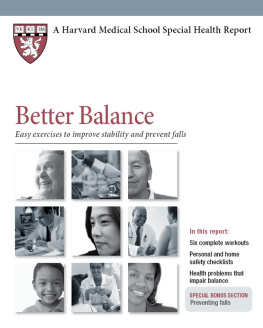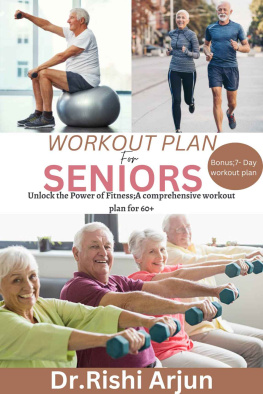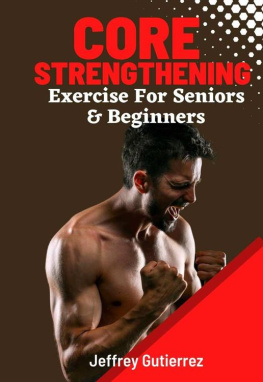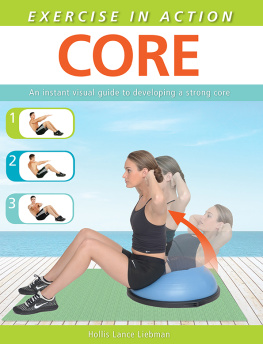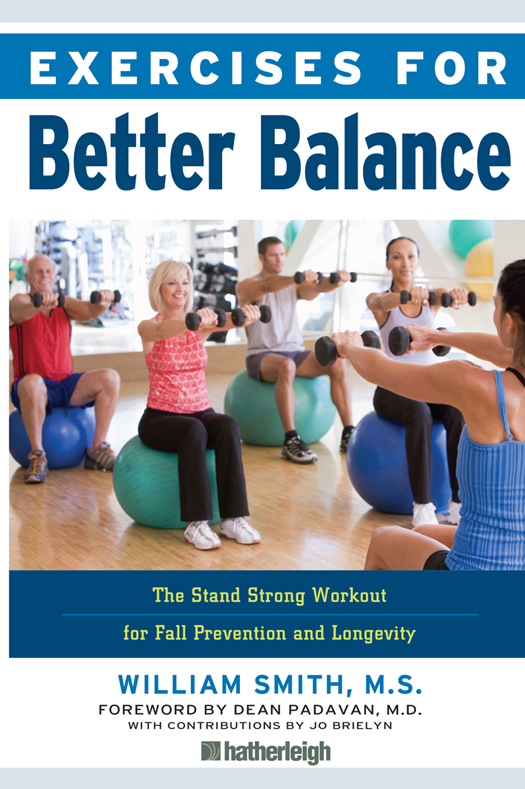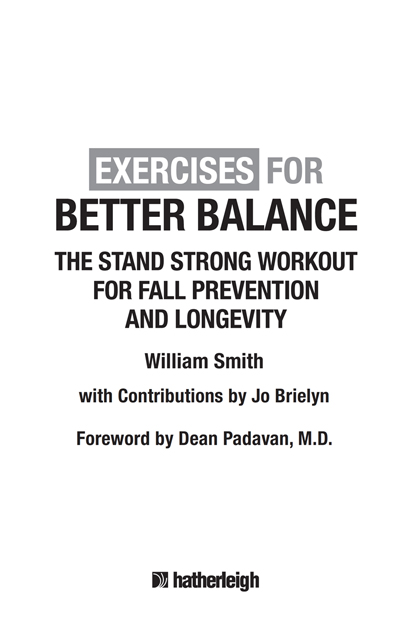Hatherleigh Press is committed to preserving and protecting the natural resources of the earth. Environmentally responsible and sustainable practices are embraced within the companys mission statement.
Visit us at www.hatherleighpress.com and register online for free offers, discounts, special events, and more.
Exercises for Better Balance
Text copyright 2015 William Smith
Library of Congress Cataloging-in-Publication Data is available.
ISBN: 978-1-57826-575-6
eBook ISBN: 978-1-57826-576-3
All rights reserved. No part of this book may be reproduced, stored in a retrieval system, or transmitted, in any form or by any means, electronic or otherwise, without written permission from the publisher.
Cover Design by Heather Daugherty
Interior Design by Nick Macagnone
Photography by Catarina Astrom
Disclaimer
Consult your physician before beginning any exercise program. The author and publisher of this book and workout disclaim any liability, personal or professional, resulting from the misapplication of any of the following procedures described in this publication.
v3.1
Table of Contents
FOREWORD
By Dean Padavan, M.D.
Whether we are aware of it or not, balance is an important part of our lives. Every day we strive for balance in our lives, whether its balancing school projects, work obligations, diet, exercise, or spending time with our family and friends. Therefore, it should not be a surprise that balance itself is such a vital component of ones overall health.
The complexities of balance are well illustrated in the first chapter of Exercises for Better Balance. The vestibular system involves an intricate relationship between your vision, ear canal, and brain, which processes an array of sensory input. Balance is omnipresent with every stage of life, from pregnancy to birth, to learning how to walk, and ultimately to the eventual loss of muscle mass (known as sarcopenia) as we get older.
With an aging population and the socio-economic constraints placed on our healthcare system, we as a society are being asked to shift our approach from treatment to injury prevention. Balance and the prevention of falls in our elderly continue to be a major area of concern in both outpatient and inpatient facilities. In 2012, the updated United States Preventative Task Force guidelines recommended exercise or physical therapy and vitamin D supplementation to prevent falls in community-dwelling adults aged 65 years or older who are at increased risk for falls.
The evolution of technology has aided in our ability to assess balance and fall risk through the use of force plates, gaming consoles, 3D motion capture systems, and hand-held devices with gyroscopes. Nevertheless, in the office setting we continue to screen for falls by looking closely at a patients age, asking for a history of falls, screening for visual disturbances, looking at confounding prescription medications, assessing potential hazardous living conditions, and performing simple tests like the get up and go test, where we ask a patient to get up from an armed chair, walk 10 feet, turn around, and sit back down again. All of these approaches help us in looking for signs of instability.
As a sports medicine physician, an assessment of balance is part of my everyday clinical practice. Whether its a professional athlete who has sustained a concussion and has abnormal balance, or a weekend warrior with hip pain and poor balance, balance is vital to injury prevention and treatment for all of my patients.
In his book, Exercises for Better Balance, William Smith takes the complexities surrounding exercise and balance and turns it into a practical guide that anyone can follow. His passion and expertise in rehabilitation is clearly demonstrated with each chapter. Having worked with William in the past, I can attest to his genuine desire in motivating others to improve their mobility and stay fit. His book is another example of how we can empower our communities to be healthier.
Time is precious and our lives are hectic, but if you continue to balance the important things in life and incorporate exercise and healthy habits, you can improve your own individual balance and overall health.
Dean Padavan, M.D.
Dean Padavan, M.D. is board certified in both Sports Medicine and Internal Medicine. He currently practices Sports Medicine for the Atlantic Health System in New Jersey and has offices in Morristown and Sparta. He is the associate team Internist for the New York Jets, and the team physician for College of St. Elizabeth in Morristown, NJ and Pope John High School in Sparta, NJ. He is the associate program director for the Atlantic Sports Health Primary Care Sports Medicine fellowship and is extensively involved with the academic research program.
INTRODUCTION
As Americans, we dont tend to think of loss of balance as a medical issue. Weve all had our share of laughs at the slapstick comedy of the unfortunate man or woman who simply cant seem to stand upright without falling over. Weve playfully teased that one family member or friend known for tripping over invisible lines and walking into walls. Even the most graceful of us have experienced those moments of amusing klutziness while overtired or distracted. But when balance issues become a reality of everyday life and the falls become more frequentand severethe laughter stops.
Trips and falls happen to everyone at one time or anotherkids, young adults, and elderly people alike. However, as adults get older, those falls can also become more dangerous, to the point of becoming potentially fatal. Falling is reported as the number one cause of death by injury in America for people 65 years of age or olderno laughing matter, clearly.
The encouraging news is that many of these falls can be prevented. Numerous balance studies have found that muscle strengthening and balance retraining programs can significantly decrease the risk of falls. Staying fit and incorporating exercises like those included in this book can help you to preserve your balance and protect your overall health.
This book is dedicated to the memory of William Corley, WWII Veteran, dedicated husband, father, grandfather, and great-grandfather. Daily physical activity was a centerpiece to his longevity and overall well-being. He followed a daily exercise routine of strength training and 5 miles of walking. Many of the same principles he followed are included in this book.
CHAPTER ONE
Stand Strong with Better Balance
C lose your eyes and stand on one foot for 1520 seconds. Were you able to do it without bracing yourself on something or placing your raised foot on the ground again? Did you feel wobbly, lightheaded or as if the room was spinning around you?








